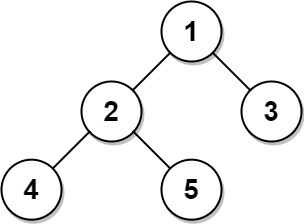- {x}
- Non-negative Integers without Consecutive Ones
- Human Traffic of Stadium
- Friend Requests II: Who Has the Most Friends
- Consecutive Available Seats
- Design Compressed String Iterator
- Can Place Flowers
- Construct String from Binary Tree
- Sales Person
- Tree Node
- Find Duplicate File in System
- Triangle Judgement
- Valid Triangle Number
- Shortest Distance in a Plane
- Shortest Distance in a Line
- Second Degree Follower
- Average Salary: Departments VS Company
- Add Bold Tag in String
- Read More...

Tree Node
Table: Tree
+-------------+------+ | Column Name | Type | +-------------+------+ | id | int | | p_id | int | +-------------+------+ id is the column with unique values for this table. Each row of this table contains information about the id of a node and the id of its parent node in a tree. The given structure is always a valid tree.
Each node in the tree can be one of three types:
- "Leaf": if the node is a leaf node.
- "Root": if the node is the root of the tree.
- "Inner": If the node is neither a leaf node nor a root node.
Write a solution to report the type of each node in the tree.
Return the result table in any order.
The result format is in the following example.
Example 1:

Input: Tree table: +----+------+ | id | p_id | +----+------+ | 1 | null | | 2 | 1 | | 3 | 1 | | 4 | 2 | | 5 | 2 | +----+------+ Output: +----+-------+ | id | type | +----+-------+ | 1 | Root | | 2 | Inner | | 3 | Leaf | | 4 | Leaf | | 5 | Leaf | +----+-------+ Explanation: Node 1 is the root node because its parent node is null and it has child nodes 2 and 3. Node 2 is an inner node because it has parent node 1 and child node 4 and 5. Nodes 3, 4, and 5 are leaf nodes because they have parent nodes and they do not have child nodes.
Example 2:

Input: Tree table: +----+------+ | id | p_id | +----+------+ | 1 | null | +----+------+ Output: +----+-------+ | id | type | +----+-------+ | 1 | Root | +----+-------+ Explanation: If there is only one node on the tree, you only need to output its root attributes.
Note: This question is the same as 3054: Binary Tree Nodes.
Solution Explanation and Code
This problem requires determining the type (Root, Inner, Leaf) of each node in a tree represented in a table. The solution leverages SQL's capabilities to efficiently classify nodes based on their parent (p_id) and child relationships.
Approach
The core idea is to check three conditions for each node:
- Root: A node is a root if its
p_idisNULL. - Inner: A node is an inner node if it's the parent of at least one other node. This is determined by checking if its
idexists in thep_idcolumn of the table. A subquery is used for this efficient check. - Leaf: If a node is neither a root nor an inner node, it's a leaf node.
This logic is implemented using SQL's CASE WHEN statement, creating a concise and efficient query.
Time Complexity Analysis
The dominant factor in the time complexity is the subquery id IN (SELECT p_id FROM Tree). In the worst-case scenario, this subquery has to scan the entire Tree table for each row in the outer query. This leads to a nested loop-like behavior, resulting in a time complexity of approximately O(N^2), where N is the number of rows in the Tree table. However, database optimizers might improve this performance significantly in practice, depending on the indexing and the specific database system used. A more optimized approach could use joins, but the given solution prioritizes readability.
Space Complexity Analysis
The space complexity is O(1) because the query uses a constant amount of extra space regardless of the input size. The output table is of the same size as the input table.
Code (MySQL)
SELECT
id,
CASE
WHEN p_id IS NULL THEN 'Root'
WHEN id IN (SELECT p_id FROM Tree) THEN 'Inner'
ELSE 'Leaf'
END AS type
FROM Tree;
This MySQL query directly implements the approach described above. The CASE WHEN statement checks the three conditions, assigning the appropriate type to each node. The result is a table with id and type columns, showing the classification of each node in the tree.
Note: While the time complexity analysis suggests O(N^2), database systems often optimize such queries significantly using indexes and query planning, leading to much better performance in practice. For extremely large datasets, exploring alternative approaches using joins or pre-computed information (e.g., storing child counts) might be beneficial.